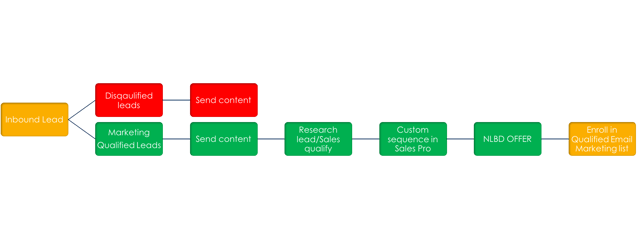
A successful technology company needs sales to survive.
Without an effective sales process to fill your pipeline and convert prospects to customers, you won't sell enough to survive. You might get lucky for a while, but to grow consistently, you need a defined process to effectively deploy your limited sales and marketing resources.
The reality is that most SMB technology companies don't have a defined process to fill their sales pipeline and close deals. Too often, the focus for early-stage tech companies is on product development and securing investor funding. Sales and marketing is often a secondary consideration.
It doesn't have to be that way! You don't need a complicated sales process - in fact a sales process that is overly complicated is rarely followed by the people entrusted to use it. You need a process that effectively focuses your sales and marketing resources to maximize results.
Like earth, wind, fire and water, a successful technology sales process needs 4 essential elements to survive.
The First Essential Element: FOCUS
A lack of focus is the most frequent problem I see when talking with technology company executives.
The thinking is that if they focus on the financial sector, they're foregoing opportunities in retail, technology and automotive. The reality is that today's technology buyers are looking for specialists, not generalists. In DemandGen Reports 2017 B2B Buyer Survey Report, 93% of buyers valued vendors that, "demonstrated experience with/knowledge of our industry." They're not looking for jacks-of-all-trades, folks!
So in order to have an effective sales process, you first need to understand where you will focus your product/service and your sales and marketing. It starts with having a clear definition of your ideal customer. You should consider factors like industry, size and other demographic/psychographic factors. Once you've identified your target customer, it becomes easier to solve for them in terms of product development and sales/marketing.
The next part of focus in your sales process is to identify the roles involved in the buying process for your solution. Even though the CTO may have the ultimate responsibility for deciding to buy, there are others involved the buying process. Two quotes from the DemandGen 2017 B2B Survey illustrate this clearly.
- "59% of respondents say they now have formal buying groups or buying committees in place to review purchases"
- "One director pointed out that the research and vendor analysis stages now involve different team members with different points of view. 'When we are looking into implementing a new system, we need to involve those who will be in it to ensure it is easy to use and will actually deliver on what we need. Some of us are involved in doing the research portion and coming up with a consideration set, so different people are involved in different phases of the purchase journey.' "
So if you concentrate on the CTO and ignore the engineers that will have to make things work, you do so at your own peril. By focusing on your ideal customer, you focus on prospects that are likely to be long-term profitable customers. You also are able to become experts in your niche and focus content and messaging on the people you want to sell to.
The Second Essential Element: QUALIFICATION
Even the largest enterprise technology companies have limited sales and marketing resources. If they don't use those resources effectively, their Cost of Customer Acquisition (CAC) increases, which in turn decreases revenue. For smaller tech companies, you waste resources on low-percentage opportunities that could be used on high-percentage plays.
That's why it's so important to qualify leads. Here are a few things to keep in mind on qualifying leads.
- Use technology to do the first round of qualification. Marketing automation technology allows you to segment and qualify your leads. If you look at the lead generation form at the bottom of this page, you will note that we ask three qualifying questions relating to industry, role within the company and whether the lead is a HubSpot customer. In our qualification process, we take the answers to these three questions to define qualified leads. We actually add one more - we're looking for US-based IP addresses. So far this month, we've generated 48 inbound leads. Of those 48 leads, 14 were Marketing Qualified Leads (MQLs). That's where we're concentrating our sales and marketing resources.
- Don't ignore non-qualified leads. While you don't want to spend a lot of time on non-qualified leads, you also don't want to ignore them. Let your technology do the work - send them the content they requested and engage them in email marketing. They just might be able to refer you to someone that is a qualified lead.
- Use qualification in your outbound sales process. We don't recommend purchasing email lists - the people on these lists are getting spammed from all angles and your probably more likely to annoy them than to sell them. You're much better off building your own opt-in lists, which is basically a form of qualification. However, if you have sales professionals responsible for generating leads, a good portion of their time should be spent qualifying the leads that they will be pursuing.
A good qualification process will enhance your ability to successfully sell in your target markets.
The Third Essential Element: PROCESSES
This seems a bit redundant, but this is really the heart of your sales process. You need to define a series of actions that your sales team will take with qualified leads, depending on how the lead was generated. For example, you will want to have a different process for a referral lead than for an inbound lead.
Your processes should be designed to help your prospects complete their buying journey while reaching mileposts that you know will increase your chances of closing the deal. A simple sales process might be to qualify leads, get them to participate in a demo, convince the buying team of the ROI and your ability to perform and execute a contract.
By having defined processes for your various marketing channels, you will employ a consistent approach in the marketplace. The sales team will be responsible for executing the process, not figuring out how they should react to every lead that comes in the door. From a management perspective, this focuses sales training and coaching on the execution.
Here's a simplified version of our sales process for inbound leads that goes up to the point of an actual opportunity.

The Fourth Essential Element: MEASUREMENT
One of the advantages of having a defined sales process is that you can measure activities of both your team and your prospect to facilitate continual improvement. You should set SMART goals for your Key Performance Indicators (KPIs) and track progress against them.
Here are some things to consider as you measure and improve your sales process.
- Measure engagement metrics. Look at things like email open rates, click rates, content downloads and lead generation. There are two perspectives you should consider. The first is whether these engagement metrics are sufficient to hit your sales goals. Do you need to invest in LinkedIn advertising? Should you re-evaluate your email marketing strategy. The second perspective is how well various aspects of your sales process resonate with your ideal customers. If you're getting a lot of website traffic and lead generation from a particular blog post, try to understand why it's resonating and build on that with your other marketing efforts.
- Measure progress to the steps in your sales process. You may find that your pipeline moves along just fine until you reach a certain milestone. Take a look at the data to identify any roadblocks that are getting in the way of your prospects completing their buyers journey and remove or reduce them.
- Measure team performance. You may find that 4 sales professionals are producing as expected with your sales process. That's a sign that the problem is with the sales professional, not the sales process. Either that person isn't following the process appropriately, needs coaching/training or isn't up to the task.
Remember, what gets measured, get's done.
There are two precursors to your sales process that we didn't touch on in this post. The first is lead generation - if you're not producing leads, there's really no point in having a sales process (or a business.) The second is sales and marketing technology. It's just not possible to execute an effective sales process without it. If youre not using technology in your sales and marketing process, get the free HubSpot Marketing software and the free HubSpot CRM. Without a defined sales process, you're just tapping in the dark.








